Since joining the Hood Museum of Art’s staff as a visitor services guide a few months ago, I have met a broom squire who was overjoyed that a broom was on view in the galleries, seen Dartmouth geography students become utterly absorbed with our landscape paintings, and talked with countless history devotees as they explored ancient art and artifacts from around the globe. This institution has something to offer to everyone, even visitors who may not be avid art enthusiasts. It is one of my favorite things about the Hood Museum––we can all find something to get excited about.
With this in mind, I wanted to apply my own degree in fashion to outline a rewarding museum visit for other fashion enthusiasts. It is not always obvious when a work of art has connections to fashion or textiles. In this post, I highlight objects now on view in Gilded: Contemporary Artists Explore Value and Worth, which runs through June 22, 2024. They are guaranteed to interest fashion and textile lovers from all walks of life.
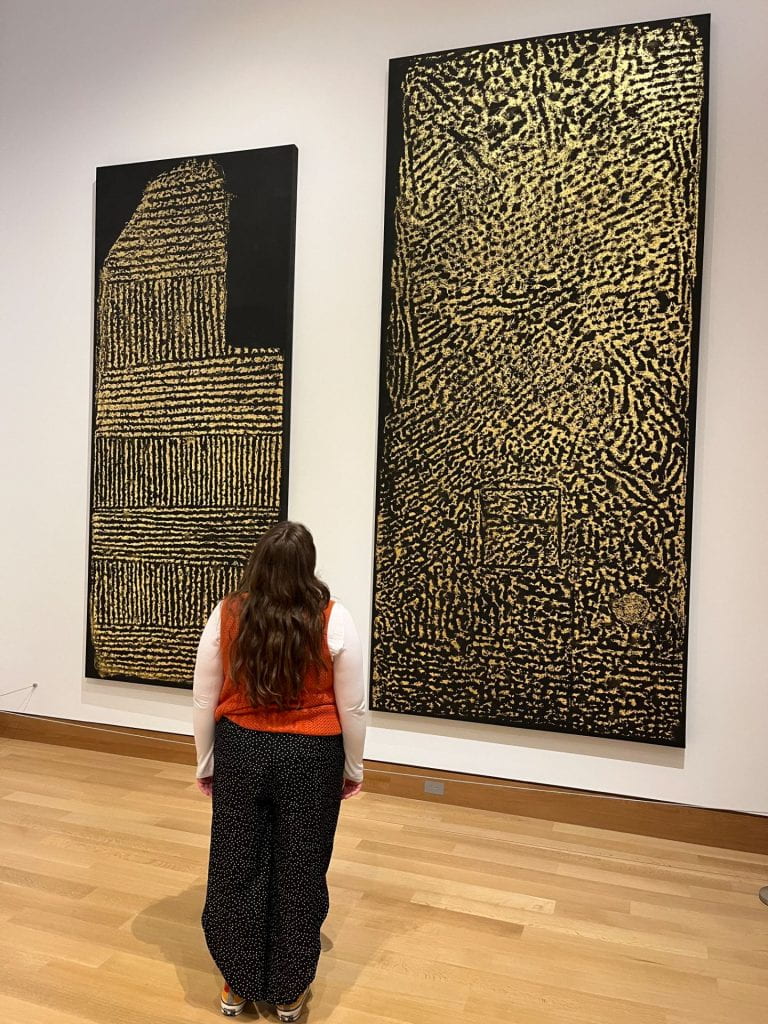
As you enter Lathrop Gallery, take note of the black and gold vertical works on the far-right wall. If your first observation about these works by James Nares, titled Greenwich I (2018) and Lafayette VII (2019), involves their size and texture, like mine did, you may be asking yourself, “How are these works connected to fashion?” I have an answer! The plain black background is used in this case to make the golden textures stand out, but it is also a very interesting aspect of these works in its own right. It is made of Evolon, a technologically advanced non-woven microfilament textile.(1) Nares laid Evolon directly onto two streets in New York City (which the works are named after). The artist then rubbed the fabric with wax, making any indentation, bump, or detail on the road visible. Nares then applied gold leaf to the wax markings, leaving some of the black Evolon exposed. On the wall to the right of these pieces is a special touch component so you can gain a better understanding of the fabric and the artist’s process (please don’t touch any actual art!).
I assume the artist chose Evolon because of its engineered mechanical properties, which make it especially durable. When thinking of fashion or fabrics, does durability come to your mind as well? Often, the glitz and glam of the apparel world sticks out to us, while the practicality of our garments takes a back seat, just as the gilding of these works draws the eye away from the Evolon background. But do you wear denim to the gym? Or cotton to go swimming? Fabric’s physical properties play as big a role in our lives as its design and aesthetics, and I love how these pieces highlight that aspect.
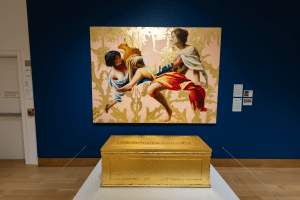
As you move further into Gilded, your eye may be drawn to the canvas on the very back wall of Hall Gallery (the furthest gallery), Angela Fraleigh’s These Things Are Your Becoming (2014). While the two women in this artwork are its focal point, the gilded floral pattern behind them is what stole the show for me, after I learned from Ashley Offill, the curator of collections, that it is not Fraleigh’s original design but instead a recreation of a fabric design manufactured in the early 1880s. According to the Metropolitan Museum of Art, which possesses the original fabric, this thistle textile was created by the firm Tiffany & Wheeler, founded by Louis Tiffany and Candace Wheeler, as a commission for Tiffany and Co., which was owned by Louis Tiffany’s father. The Met states that it is unclear whether the fabric design was created by Candace Wheeler or Louis Tiffany.(2)
After further discussion with Offill about Candace Wheeler’s work as a textile designer, I learned that she is in fact the likely designer of the original silk and metal-threaded damask pattern, and I became enthralled by her many contributions to the textile industry. This thistle design featured a unique pairing of “gold metallic thread and gray-blue silk,” an indication of Wheeler’s innovative work.(3) She was considered an expert on decorative textiles by her peers, and she devoted time and resources to cultivating younger artists, primarily women, to pave the way for those who shared her passion and wished to enter the industry as well.(4) After learning all of this, I gained a whole new perspective on Fraleigh’s artwork. In choosing to cover the floral design in gold, that is, she directs our attention to not only Wheeler’s career as an artist but also her value as a person.
After viewing Fraleigh’s piece, you can head back into Jaffe Gallery to see Blue Puddles (2021) by Summer Wheat on your right. When I first noticed the 3D effect achieved by this artist, I assumed the work was embroidered. Though I soon realized it was not, Summer Wheat used an equally innovative and intriguing process, pressing paint through aluminum mesh to create the bubbling, textured effect on the canvas and its illusion of thread or beads. If you are someone who needs to feel something to understand it, there is a touch component next to this work as well.
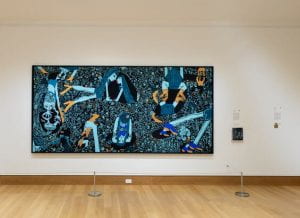
When I look at Blue Puddles, my mind fills with its fashion connections. While aluminum mesh would be incredibly uncomfortable to wear, its pattern is reminiscent of fishnet tights and vintage basketball jerseys. Also visible in the work is a pair of shoes that are gilded on the bottom, which recalls Christian Louboutin’s famous “red bottoms,” the trademarked illustrious red soles that convey the brand’s luxury status. There are also elements of body modification in the work––some figures’ bright pink lips and nails are especially striking against the textured background.
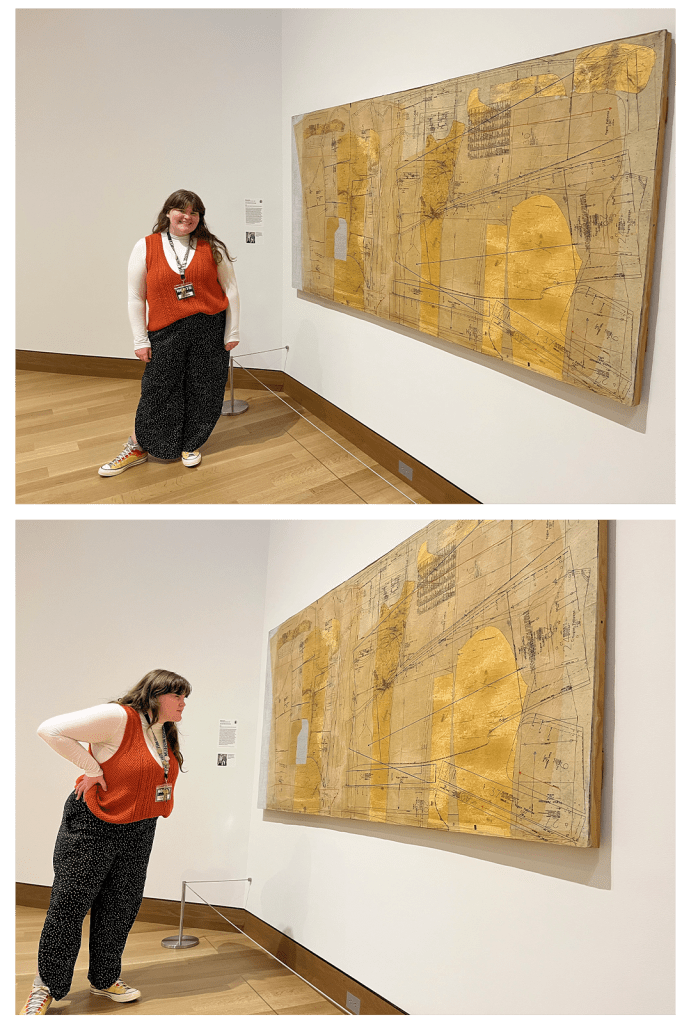
Finally, as you exit Jaffe Gallery and reenter Lathrop, you will see my favorite work in the exhibition, Ronny Quevedo’s Zoot Suit Riot at Qoricancha (2017), on the tripartite wall behind Sherin Guirguis’s hanging sculpture Larmes d’Isis II (2019). While it may not initially draw your eye amid the larger works, its intricate details are worth a second look. Here, Quevedo places a Vogue sewing pattern of the renowned 1940s zoot suit (a broad-shouldered drape jacket and balloon-leg trousers) across the canvas. In theory, these shapes could be used by anyone to assemble their own zoot suit at home. The artist’s use of actual pattern pieces is what first caught my attention, as it is a material I never expected to see in a work of art. The sewing instructions and pattern paper transport me back to many unglamorous times hunched over a cutting table or sewing machine.
I found it fascinating that Quevedo focused on the very beginning of the sewing process—on papers that are typically thrown out after the completion of a garment—and made that material permanent through his work. The artist then covered the pattern shapes with gold and silver leaf, enshrining these tools, which can be found scattered throughout most sewing studios, in the precious metals. This act reminds me of the reasons why I became invested in fashion in the first place. Beyond looks and aesthetics, dress and fashion have a huge impact on individual identity and group belonging. They can also impact societies and cultures, both negatively and positively. There is just so much to learn through clothing, and Quevedo reminded me about the actual and virtual values and extensive history of fashion.
Gilded is located on the second floor of the museum in the Lathrop, Jaffe, and Hall Galleries. Look for visitor services guides wearing Hood Museum lanyards at the front desk and inside the galleries for any assistance you may need. If you happen to see me in the galleries, please say hi. I would love to continue this conversation in person!
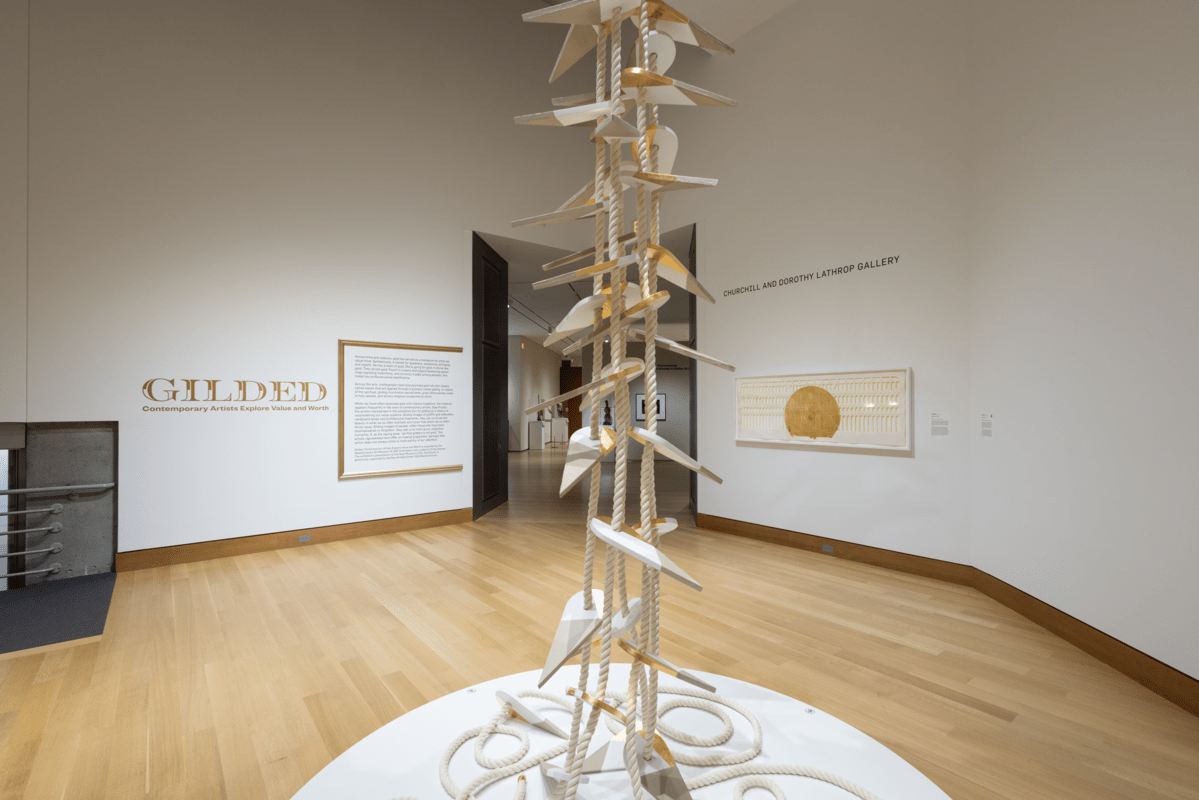
This post was authored by: Delainey Lantz, Visitor Services Guide

ABOUT THE AUTHOR
Delainey began working at the Hood Museum of Art in 2023 as a Visitor Services Guide. She graduated from West Virginia University with a B.S. in Fashion, Dress, and Merchandising and a minor in event planning. She has previous experience interning at Bliss House Musuem, a vintage women’s fashion museum in Portland, Oregon, working as a research assistant studying consumer behavior, and volunteering at the Art Museum of West Virginia University. She has curated her own dress exhibition utilizing WVU’s Historic Dress & Textile Collection to showcase plaid’s social and historic impacts on individuals and communities.
Notes
- Evolon®, https://evolon.freudenberg-pm.com/evolon_technology/technology.
- “Thistle Textile,” The Metropolitan Museum of Art, https://www.metmuseum.org/art/collection/search/14019.
- “Thistle Textile,” The Metropolitan Museum of Art, https://www.metmuseum.org/art/collection/search/14019.
- Amelia Peck, “Candace Wheeler (1827–1923),” The Met’s Heilbrunn Timeline of Art History, October 2004, https://www.metmuseum.org/toah/hd/cawh/hd_cawh.htm.
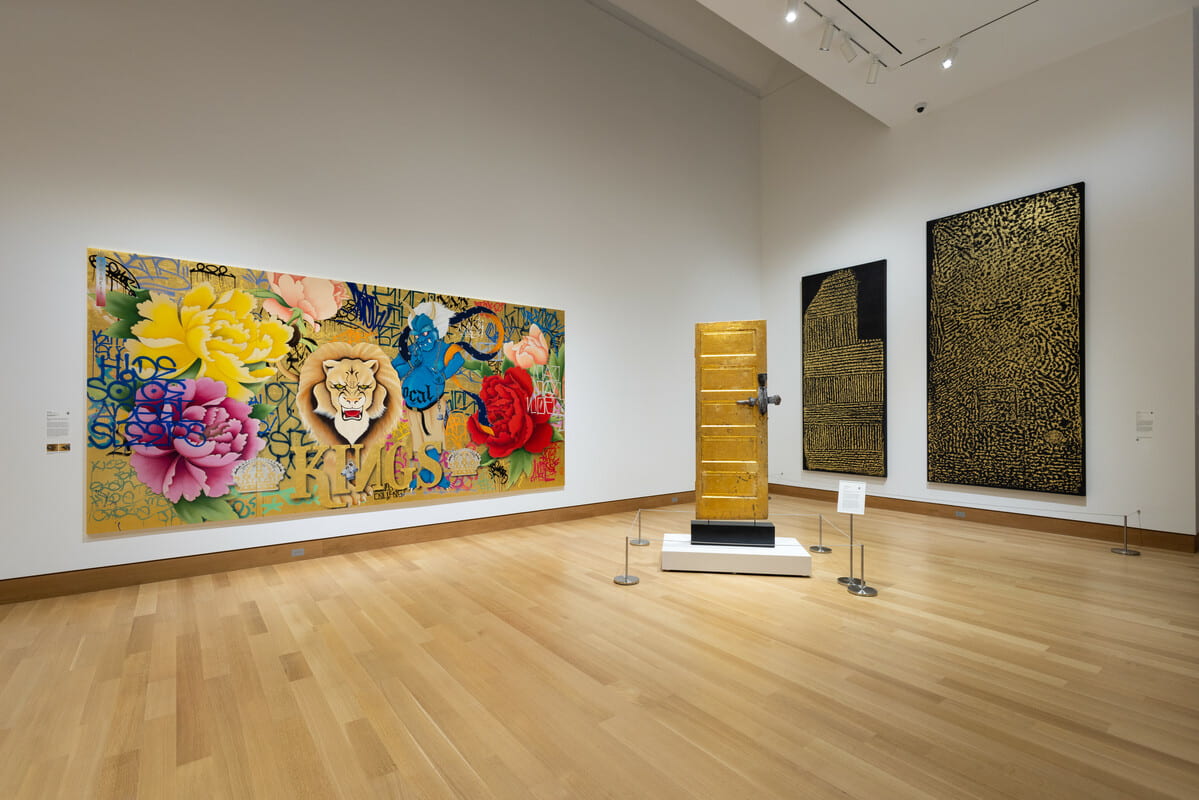
Comments